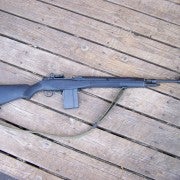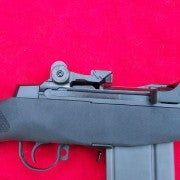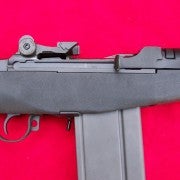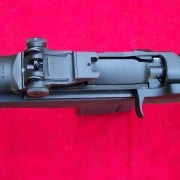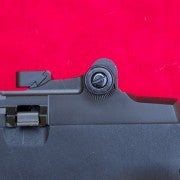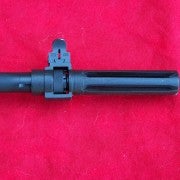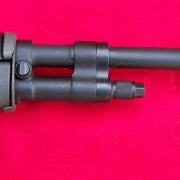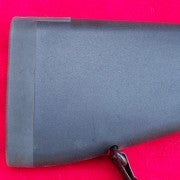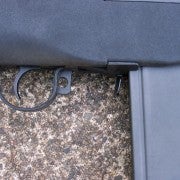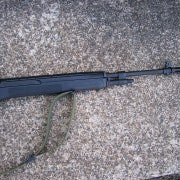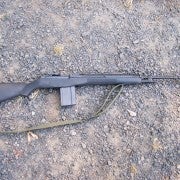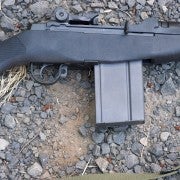Review: Springfield M1A Standard
Pat Cascio 12.03.15
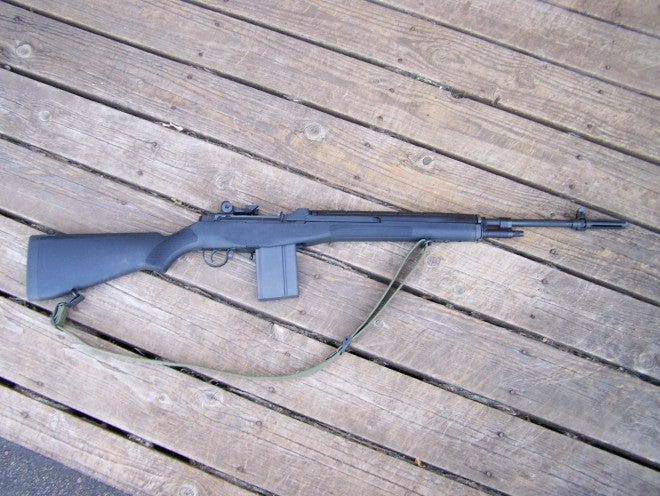
In 1969, I found myself on active duty (in basic combat training at Ft. Ord, CA) and our issued weapon was the M-14. I was a scrawny kid, weighing in at 135-lbs. But when I finished BCT and Infantry School, I was 165-lbs of muscle. In any event, I didn’t find the “kick” of the M-14 objectionable in the least. The one thing I didn’t much care for was the heavy weight of the M-14. During BCT, during rifle qualifications I qualified as “Expert” with the M-14.
I later returned to my National Guard unit in Chicago, where I worked for several years full-time. I was asked to join the state rifle and pistol team and was issued a match-grade M-14 and match-grade 1911 to use in our matches, along with all the ammo I wanted (and believe me, I had untold number of .50 caliber ammo cans full of match .45ACP and match .308 ammo). I don’t know if shooting just came natural to me or if it was the training I received from some country cousins, Moe and Abner (their real names), when I visited them in Kentucky when I was 15-yrs old. Both of those boys could shoot and they taught me a thing or two. In any event, I won every rifle match I entered in my category, and I used my issued, iron-sighted match-grade M-14. Shooting just seemed to come easy to me for some reason.
I longed for the day when I could own my own M-14. Of course, that was not to be since they are a restricted firearm, and I wasn’t about to jump through the red tape to own a select-fire rifle, nor did I have the funds to purchase one. It wasn’t until many years later, that Springfield Armory came out with a civilian legal, semiautomatic version of the M-14, that they called the M1A. This was way back in 1974. I eventually got my hands on an M1A, and I’ve owned several different models since then.
My favorite model is the Plain Jane M1A Standard Model, and this is probably because it is as close as one can come to the military’s M-14 rifle. From 1959 until 1970, the M-14 was the standard issue rifle in the US military until it was replaced with the M-16. Personally, I’ve always thought it was a mistake to phase-out the M-14, but no one asked my opinion. Because of long engagements in Iraq and Afghanistan, some of the few remaining M-14s in our inventory were dusted off and are being used for engaging the enemy by our troops at long distances on the battlefield–distances that the 5.56mm round can’t handle.
M1A Standard Basics
A quick look at the M1A Standard Model is in order. I have the model with a black polymer stock, and it shaves close to a half pound off the walnut stock model. Plus, in my neck of the woods (Western Oregon) we get a lot of rain, and wooden stock rifles sometimes have problems with the wood swelling, throwing your accuracy out the window. So, the polymer model suits my tastes just fine at 8.8-lbs empty.
The M1A has a barrel that is 22″ long with a 1:11 twist rate, with a very effective flash suppressor on it. BTW, the M1A will safely shoot both 7.62 NATO rounds as well as .308 Winchester ammo. The .308 Win rounds are a bit hotter than the 7.62 NATO rounds. Overall length of the M1A is 44.33″. Yes, it’s a bit long, but that long barrel really aids in accuracy at long distances. Trigger pull is standard mil-spec in that it is two-stage with some take-up before you feel resistance and the gun fires. The trigger’s pull weight is 5-6 lbs. My match-grad M-14 had a 3.5-lbs trigger pull, but I find the pull on the M1A to be just perfect. I don’t want or need it lighter. The front sight on the M1A is National Match, and the rear sight is mil-spec aperture. One of the best military rear sights ever made in my humble opinion. The rear sight is fully adjustable for windage and elevation, too.
Springfield Armory supplies all their M1A models with a 10-round detachable magazine (darn). The magazine can be easily removed, with the ambidextrous mag release in front of the trigger guard. However, you can use 5-round, 20-round, and even 25-round magazines (where legal). The absolute best 20 and 25 round magazines available are those made by Check Mate Industries, and I get mine from the nice folks at US Tactical Supply in Albany, OR. I also have a good supply of “W” marked 20-round magazines from CDNN Sports. And even though they are marked with a “W,” I don’t believe they were or are made by Westinghouse. Still, I’ve had no problems with the “W” marked mags; they feed and function just fine. However, if you want the best, go with the Check Mate Industries mags.
The M1A’s safety is the same as the M-1 Garand: in the front of the trigger guard. Pull back and the gun is on safe; push it forward with your trigger finger to take it off safe, and you’re ready to fire. The poly butt stock has a nice rubber pad on it, unlike the all-steel versions found on the M-14, and wood stocked M1As
The M1A and M-14 don’t require a lot of lubrication–in most cases, less is best. These days I use Italian Gun Grease products for all my lube purposes on my firearms. One area that is often neglected on the M1A when it comes to lubrication is the roller cam bolt. I also squeeze a little Italian Gun Grease (not oil) into that area between the cam on the bolt and the operating rod. For the other lube areas, the rails–I used Italian Gun Grease “Tactical Oil” and it’s the best.
Shooting the M1A
I’ve never had any problems with any Springfield Armory M1A rifles that I’ve ever owned. They have all been 100% reliable, no matter what ammo I’ve used in them. For this article, in my testing I used Black Hills Ammunition 168-gr Match ammo, and from Buffalo Bore Ammunition I used their 175-grain “Sniper” load. Both have proven to be outstanding performers for me in any rifles I’ve used this ammo in. I did run some Russian-made, steel-cased ammo through my M1A Standard sample and had no problems at all.
I didn’t have access to my usual shooting area up in the mountains, so I was limited to doing my accuracy testing at only 50 yards, using a rolled-up sleeping bag over the hood of my SUV. With both the Black Hills 168-gr Match ammo and the Buffalo Bore 175.gr “Sniper” ammo, if I did my part I could easily shoot one hole groups all day long–that converts to around 1 MOA. If my “Standard” M1A model shoots this well, just imagine how much better the “Loaded” or “better” M1A models can shoot?
I was totally impressed and blown away with the accuracy of my Standard model, and there was no clear winner between the Black Hills and Buffalo Bore loads, other than the 175-gr Buffalo Bore load shot a tiny bit higher, which was to be expected with the heavier bullet. I don’t think you can go wrong with either loading; the Black Hills 168-gr load has been used for years to win long-range shooting matches all over the country, and it is the preferred load for our military long-range shooting teams. If it’s good enough for them, it’s good enough for me. I shoot quite a bit of the Black Hills loads, actually burned up several hundred rounds in my testing. I only had two boxes of the Buffalo Bore loads on-hand, but I also burned-up those two boxes in my testing.
For whatever reason, many folks love the Russian-design AK-47, which is much older than the M-14 is, but some folks consider the M-14 (M1A) design to be “antiquated” for some reason. However, no one says the AK-47 design is out of date or old. Hm? I own several AK-47s, and I wouldn’t hesitate to take them into battle. They are 100% reliable and accurate enough for close-in combat ranges. However, where pin-point accuracy is required, I’d pick an M1A for long-range shooting with plenty of knock down power and the most accuracy one could possibly want. I don’t see the M-14/M1A as being antiquated in the least; the design works. It’s based on the famous M-1 Garand from WWII, and it’s a fairly simple design, too. It doesn’t take a lot of special care or attention to keep it running like the M-16/M4 does.
There aren’t a lot of magazine pouches around these days for the 20-round M-14/M1A and similar sized magazines, and I have some of the best. They were made for the US Navy, and the US Navy still stocks M-14s on their ships. These mag pouches are made out of heavy-duty Nylon, and each pouch holds two mags with a divider “curtain” so the mags don’t rattle against one another. My super-secret source only has a very limited number of these magazine pouches left, so I can’t reveal the source. However, you can go to Charley’s Surplus and find the old two mag canvas 1956-mag pouches in like-new condition. I like these M-14 mag pouches because the clip onto my A.L.I.C.E. gear and pistol belt. I’m old school and rarely use “tactical vests” for carrying spare magazines. Pick-up a couple 3 or 4 of these two-mag pouches, and be sure to also order a genuine canvas (or Nylon) M-14 sling from Charley’s and your good to go.
I know a lot of readers will complain that the M1A “only” holds 20-round in the mag–unless you stick a 25-round mag in there. And my answer to that is, if you hit what you’re aiming at and not spraying and praying, you don’t need a 30-round mag like the AK or AR uses. If you require a bigger magazine, check out the X-Mags at US Tactical Supply. They are a small drum mag that holds 50 rounds and they are totally reliable. If I were going into a hot combat zone, I would have my M1A loaded with the X-Mag. 50 rounds on-tap would keep the bad guy’s heads down, and I would seek cover and reload with 20-round mags from my mag pouches.
You can also use the M1A for hunting. Many states require that you use a semi auto rifle that will only hold 5 rounds in the magazine, and these mags are plentiful. For the states that allow a 10-round mag, you’re good to go because Springfield Armory supplies each gun with one 10-round mag. If you need an optic on your M1A, there are quite a few options out there, too.
The M1A has always been in short supply, and for good reason, they are extremely popular. So, don’t expect to find one on the rack at your local gun shop. You might have to shop around, or have your gun dealer order one. And prices vary depending on which model of M1A you might want. So shop around, and one of the best places is http://www.gunbroker.com/–for pricing an availability.
By no means is the M1A or M-14 antiquated, as some believe. It’s as popular as ever, and it can do it all–especially if you are looking for long-range accurate shooting with the serious knock-down power of the 7.62 NATO or .308 Winchester round. This round will take most big game in the Lower 48, and it will save your bacon on the battlefield, too! The M1A/M-14 are “battle rifles” meant for serious work at serious distances, with a serious round for taking out the enemy or taking game for the table.
